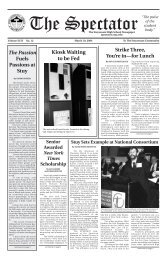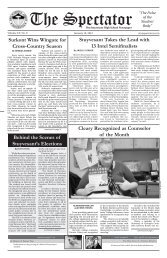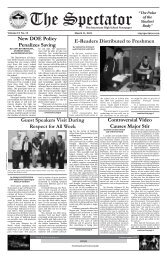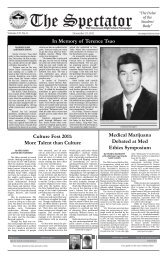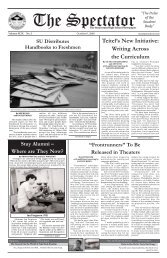Wands Out, Phones Away Speech & Debate Team - The Stuyvesant ...
Wands Out, Phones Away Speech & Debate Team - The Stuyvesant ...
Wands Out, Phones Away Speech & Debate Team - The Stuyvesant ...
You also want an ePaper? Increase the reach of your titles
YUMPU automatically turns print PDFs into web optimized ePapers that Google loves.
Courtesy of tribeca.com/festival<br />
Page 12 <strong>The</strong> Spectator • May 11, 2009<br />
Tribeca Film Festival<br />
“Soundtrack for a Revolution”:<br />
Who Stole the Soul?<br />
Anthony Hamilton and the Blind Boys of Alabama offered slightly more soulful renditions<br />
of civil rights songs than did the other singers featured in “Soundtrack for a Revolution.”<br />
By ALAN SAGE<br />
It’s hard to screw up a civil<br />
rights movie.<br />
“Soundtrack for a Revolution,”<br />
directed by Dan Sturman<br />
and Bill Guttentag, tries to offer a<br />
new perspective on the incredible<br />
footage of the civil rights movement<br />
by telling the movement’s<br />
story through song. While some<br />
of their innovations to the classic<br />
and forever heart-wrenching<br />
footage are successful—mainly<br />
the ‘unique’ interviews and the<br />
narration of the story through<br />
song—the modern, melodramatic<br />
renditions of classic civil rights<br />
songs are beyond atrocious.<br />
<strong>The</strong> film<br />
starts to go<br />
downhill after<br />
Joss Stone’s<br />
“Keep Your Eyes<br />
on the Prize.”<br />
<strong>The</strong> film’s interviews are<br />
funny and spirited. Comments<br />
like “I never understood why<br />
graveyards had to be segregated”<br />
from Rev. Samuel ‘Billy’ Kyels or<br />
“<strong>The</strong>se white people are crazy”<br />
from civil rights activist Charles<br />
McDew recur throughout the<br />
By ALAN SAGE<br />
<strong>The</strong> film is essentially a portrayal<br />
of the mind of a basketball<br />
player in action, complete<br />
with uncensored thoughts and<br />
close-up images of the ball almost<br />
hitting the camera. On the<br />
surface it could have just been<br />
footage ripped from ESPN, but<br />
would Spike Lee do something as<br />
straightforward as that?<br />
Admittedly, if you don’t like<br />
watching basketball games, you<br />
probably won’t enjoy Spike Lee’s<br />
new film, “Kobe Doin’ Work.”<br />
But Lee’s film still goes far beyond<br />
a typical sports movie. Lee<br />
interviewed Kobe Bryant while<br />
he watched footage of himself<br />
playing in a game between the<br />
L.A. Lakers and the San Antonio<br />
Spurs. Lee seems to have aimed<br />
to give a picture of what went<br />
on in Bryant’s mind, with footage<br />
from team meetings and the<br />
court, recordings of Bryant’s every<br />
word on the court and constant<br />
postgame commentary<br />
from Bryant.<br />
Despite the interesting idea<br />
behind the film, the end product’s<br />
quality is questionable.<br />
film. In one of the most insightful<br />
of the film’s interviews, Rev.<br />
Ed King describes how a white<br />
man sympathetic to blacks’<br />
plight helped them prepare for<br />
the Woolworths sit-ins by playing<br />
the role of a white policeman.<br />
King describes how everyone<br />
laughed when the man said<br />
“Sir” or “Please,” since no white<br />
policeman would offer anything<br />
near such politeness.<br />
Civil rights footage almost<br />
always engages the audience<br />
since it’s filled with so many passionate<br />
figures and moments.<br />
Even so, Sturman and Guttentag<br />
chose particularly passionate<br />
and engaging shots and placed<br />
them well throughout the film.<br />
President Lyndon B. Johnson’s<br />
“We Shall Overcome” speech is<br />
usually bypassed for speeches<br />
by John F. Kennedy or Dr. Martin<br />
Luther King Jr. in civil rights<br />
films, perhaps because of Johnson’s<br />
legacy, but placed right<br />
after footage of the Selma-Washington<br />
march, it’s particularly effective<br />
in the film.<br />
<strong>The</strong> film starts to go downhill<br />
after Joss Stone’s “Keep Your Eyes<br />
on the Prize.” Stone was clearly<br />
trying to offer a soulful performance,<br />
but her attempted soulfulness<br />
ended up in a screechy<br />
melodramatic rendition of a<br />
song meant to be performed tenderly<br />
and mournfully. Thankfully,<br />
the directors saved “We Shall<br />
Overcome” for the ending credits,<br />
allowing the audience to exit<br />
and avoid collaboration between<br />
“Kobe Doin’ Work”: A Nice Shot<br />
After a while, Bryant runs out<br />
of interesting things to say. Perhaps<br />
more importantly, the footage<br />
is repetitive and much of the<br />
same as footage broadcast on<br />
sports networks. <strong>The</strong> ‘behindthe-scenes’<br />
footage consists of<br />
a bunch of sweaty guys drinking<br />
Gatorade, with Bryant occasionally<br />
offering his teammates some<br />
ideas for strategy during the next<br />
half of the game.<br />
“Couple of minutes go by,<br />
and all of a sudden your emotions<br />
settle, and you’re ready<br />
to play the game.” Quotes from<br />
Bryant only mirror whatever’s<br />
happening on the screen. Bryant<br />
discusses his basketball philosophy<br />
and his ideas about the<br />
importance of execution. He tells<br />
the audience about his relationship<br />
with Lakers Coach Phil Jackson.<br />
But Bryant reveals very little<br />
about what emotions or mindset<br />
he has during the game. He<br />
goes off on long tangents, talking<br />
about his interactions on the field<br />
with Spurs player Kurt Thomas<br />
or about how he’s become more<br />
of a director on his team than a<br />
straight scorer.<br />
<strong>The</strong> film’s unimpressive mu-<br />
a group of singers trying too hard<br />
to be soulful.<br />
<strong>The</strong> footage of civil rights<br />
activists singing the same songs<br />
during the 60s is far more compelling.<br />
One section of the film<br />
shows a woman singing about<br />
the infamous Alabama governor<br />
George Wallace with lyrics like<br />
“he must be removed just like a<br />
can of garbage in an alley.” Another<br />
striking scene shows a<br />
sweating woman singing “Keep<br />
on Walking” with the real heartfelt<br />
passion that the contemporary<br />
singers lack in the film.<br />
<strong>The</strong> footage<br />
of civil rights<br />
activists singing<br />
the same songs<br />
during the 60s<br />
is far more<br />
compelling.<br />
Just about the only time the<br />
modern renditions are effective<br />
is during the sequences about the<br />
Freedom Summer, when Northern<br />
college students went to<br />
Mississippi to aid the civil rights<br />
cause. <strong>The</strong> footage is accompanied<br />
by Wyclef Jean’s rendition<br />
of Phil Ochs’ “Here’s to the State<br />
of Mississippi.” While Jean’s<br />
interpretation is more serious<br />
and straightforward than Ochs’<br />
slightly sarcastic Arlo Guthrieesque<br />
original, it nonetheless<br />
provides a nice accompaniment<br />
to footage of innocent Northerners<br />
heading into danger—and for<br />
some death—in Mississippi.<br />
<strong>The</strong> film offers a somewhat<br />
interesting perspective on the<br />
civil rights movement, but nothing<br />
revolutionary or particularly<br />
original. “Soundtrack for a Revolution”<br />
might be more effective<br />
if it had included real revolutionary<br />
singers, rather than pop<br />
sensations like John Legend and<br />
Wyclef Jean.<br />
sic selections only further show<br />
how the ‘straight footage’ approach<br />
limited Lee. Boring muzak<br />
comes on during some portions<br />
of the game, but the music seems<br />
out of place and certainly doesn’t<br />
add to the audience’s emotional<br />
experience of the film.<br />
Lee tried to use cinematic effects<br />
to further destroy the 4th<br />
wall. But an occasional blackand-white<br />
freeze frame doesn’t<br />
cut it. Even Bryant’s perpetual<br />
mumbling just makes the audience<br />
become bored rather than<br />
follow his movements more<br />
closely. “If you’re playing against<br />
a great player, of course he’s going<br />
to make you look bad sometimes.”<br />
Bryant’s unimportant<br />
words of wisdom certainly don’t<br />
add to the film’s quality.<br />
<strong>The</strong> audience feels unsatisfied<br />
as Kobe pulls out of a parking<br />
lot in his SUV and the film ends.<br />
Bryant talks about execution and<br />
its importance throughout the<br />
film. Lee ought to have listened<br />
to Bryant and ensured that “Kobe<br />
Doin’ Work” exhibited strong execution<br />
in addition to just an interesting<br />
and experimental idea.<br />
Transcendent Man:<br />
Sci-Fi Freak<br />
or Super Genius?<br />
Millionaire inventor Ray Kurzweil shares a moment with the camera on an international<br />
trip to spread the theories of his book, <strong>The</strong> Singularity is Near.<br />
By LEILI SABER<br />
With a dramatic Morgan Freeman<br />
voiceover and 3D images of<br />
the constellations, Transcendent<br />
Man, perhaps the most theatrical<br />
documentary of the Tribeca<br />
Film Festival, begins. <strong>The</strong> documentary,<br />
directed and produced<br />
by Robert Ptolemy, focuses on<br />
the wildly futuristic ideas of Ray<br />
Kurzweil, inventor of the chargecoupled<br />
flatbed scanner and author<br />
of <strong>The</strong> Singularity is Near.<br />
Kurzweil asserts<br />
that technology<br />
grows at such an<br />
exponential rate<br />
that technology<br />
and humans will<br />
blend together<br />
by 2029.<br />
With the help of music reminiscent<br />
of the Da Vinci Code<br />
soundtrack, the do cu mentary<br />
focuses on Kurzweil’s personal<br />
life as well as on the abnormal<br />
ideas of his prophetic book. Essentially,<br />
Kurzweil asserts that<br />
technology grows at an exponential<br />
rate such that humans and<br />
technology will blend together<br />
by 2029. While the ideas are certainly<br />
interesting, the explanations<br />
behind the theories are far<br />
from it. Ptolemy disappoints by<br />
either using footage of Kurzweil<br />
explaining his theories to live<br />
audiences, or doing the typical<br />
“documentary shot”—a close-up<br />
of the inventor sitting in an armchair<br />
in front of a monochromatic<br />
backdrop. <strong>The</strong> information is<br />
comprehensible, but the magnitude<br />
of the ideas being projected<br />
is difficult to take in.<br />
Anecdotes of Kurzweil’s deceased<br />
father and footage of the<br />
inventor’s sorrow help make<br />
the documentary feel less overwhelming<br />
and a bit more like a<br />
mainstream film—a welcome<br />
change after 3D images of the<br />
galaxy or quantitative information.<br />
Yet, just as Kurzweil begins<br />
to seem like a real person rather<br />
than a slightly mad scientist, he<br />
ruins the moment by announcing<br />
that he intends to bring his<br />
father back to life. Kurzweil has<br />
saved an entire storage room full<br />
of his father’s possessions to feed<br />
to a computer in order to create<br />
a person as close to his father as<br />
possible. Cue the Twilight Zone<br />
theme music.<br />
Ptolemy, fully aware of the<br />
skepticism surrounding his<br />
subject’s work, adds additional<br />
characters popping up throughout<br />
the film to try to make his<br />
theories sound more believable.<br />
<strong>The</strong>se additions are mostly people<br />
of Kurzweil’s group—notable<br />
professors, other inventors, sci-fi<br />
fans—but in order to appeal to<br />
the average viewer in the audience<br />
wondering if this is all a<br />
joke, Ptolemy adds in popular<br />
celebrities as some sort of reassurance.<br />
Notable actor William<br />
Shatner completely supports<br />
Kurzweil and all of his ideas,<br />
especially the one about living<br />
forever, or extending life (interestingly<br />
enough, the ex-captain<br />
Kirk is 78 years old). Another<br />
significant appearance is that of<br />
singing sensation Stevie Wonder,<br />
who has been close friends with<br />
Kurzweil since his invention of<br />
the Kurzweil Reading Machine,<br />
which allows blind people to understand<br />
written text by having<br />
the computer read it out loud.<br />
Kurzweil makes endless references<br />
throughout the film about<br />
how the combination of man<br />
and machine will enable humans<br />
to become gods, so it is only a<br />
matter of time before a religious<br />
confrontation appeared on the<br />
screen. Ptolemy spends less<br />
time on it that would have been<br />
expected, showing clips of Kurzweil<br />
speaking on air with a host<br />
of a religious radio station. What<br />
could have been the most interesting<br />
part of the film quickly becomes<br />
a passive religion versus<br />
science discussion. Shortly after,<br />
Kurzweil lectures at a Christian<br />
Association, but instead of the<br />
expected crosses and rotten tomatoes<br />
being thrown at him, the<br />
crowd cheered endlessly.<br />
Kurzeil has<br />
saved most of<br />
his deceased<br />
father’s belongings,<br />
in hopes<br />
of bringing him<br />
back to life.<br />
Mercifully, as the attention<br />
of numerous audience members<br />
wound down, so did the altogether<br />
dry film. Like just about<br />
every other documentary on<br />
earth, the final scenes of Transcendent<br />
Man were spent discussing<br />
the future—as if Kurzweil<br />
hadn’t spent an hour and a half<br />
talking about just that. “Does<br />
God exist?” Kurzweil said. “Not<br />
yet.” Cue the cast list and masses<br />
hurrying to exit the theater.<br />
Courtesy of tribeca.com/festival



